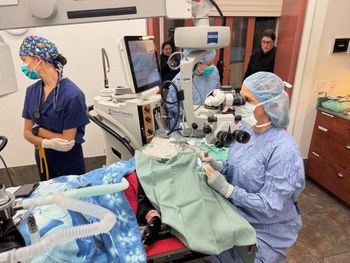
New tricks to take the pressure off dogs with glaucoma
Veterinarians may be gaining the upper hand on this frustrating disease.
Glaucoma treatment options? Sammy is ready to shake on it! (Photo: Shutterstock.com)Are you still reaching for the mannitol to manage emergency cases of canine glaucoma?
Emergency medical treatments
Dr. Bobofchak's first-choice treatment in most cases of glaucoma is a topical prostaglandin analogue-and good news! Generic latanoprost is available and an inexpensive option for your clients. This drug works well for emergency cases and will drop intraocular pressure within an hour in most cases. Keep a bottle at your hospital for emergencies. The main side effect is extreme miosis.
Hyperosmotics temporarily lower intraocular pressure in emergency situations, but they only work for primary glaucoma, are only a Band-Aid, and have side effects. Dr. Bobofchak says the classic treatment is intravenous mannitol (1 to 2 g/kg given slow intravenously over 20 to 30 minutes). Oral glycerin is another option, but Dr. Bobofchak doesn't use it because in his experience it can induce emesis.
“Maintenance” medical treatments
Glaucoma is still a disease we don't know how to beat, says Dr. Bobofchak. Provide full disclosure that most treatments are just designed to buy time until the client can pursue surgical treatment. Very few dogs with glaucoma can be managed long term with medications alone, but Dr. Bobofchak says you can maintain many patients over a year with appropriate medical therapy. Here are his top picks:
• Oral carbonic anhydrase inhibitors decrease pressure by lowering aqueous production and are a great choice for patients with anterior lens luxation because they do not cause miosis. Oral methazolamide dosed at 2 to 5 mg/kg b.i.d. is readily available but is expensive, can cause metabolic acidosis, and is contraindicated in patients with reduced renal function. Dr. Bobofchak prefers topical carbonic anhydrase inhibitors over oral administration because they are equally effective and don't have any systemic effects. Bonus: Topical dorzolamide is available as a generic.
• Beta blockers decrease production in the ciliary body, and timolol is most commonly used for mild cases. But they are not a great choice for emergency cases or solo therapy, says Dr. Bobofchak. He prescribes beta blockers as adjunct or prophylactic therapy. Cosopt, a combination of dorzolamide and timolol, is a good option to consider for difficult cases.
• Miotics can lower pressure by opening the iridocorneal angle to allow greater drainage. Pilocarpine is still the mainstay treatment, says Dr. Bobofchak. But prices have increased and the preparation is very irritating to 50 percent of the canine population.
Surgical therapy
“The treatment chosen by the ophthalmologist is based on experience and comfort level with the procedure and how to manage the follow-up period,” says Dr. Bobofchak. Some choose to use shunts, but he likes to use laser cyclophotocoagulation, which is aimed at decreasing aqueous production by destroying part of the ciliary body. Two options are available. Transscleral cyclophotocoagulation has been around awhile and is performed by placing a laser probe on the exterior of the sclera. Dr. Bobofchak says the hot new trend is endoscopic cyclophotocoagulation, which involves making a small incision in the cornea and inserting an endoscope that allows direct visualization and laser ablation of the ciliary body. It does require lens removal.
The ciliary body can also be ablated by injection of gentamycin into the vitreous cavity. Dr. Bobofchak says this is considered a palliative salvage procedure to reduce pain. It can be done without general anesthesia and is an option for clients on a budget. Cryotherapy is also available. So many options!
Communication is key
Explaining glaucoma to pet parents can be hard. Dr. Bobofchak likes to use the sink analogy and calls it a plumbing problem: inside the eye, the sink is always on and if the drain clogs up then the sink overfills, and BOOM. Glaucoma.
Clients tend to feel bad that they missed the signs or waited a day to see if it got better, and now their dog is blind in one eye. Let them know that this happens a lot, it's not their fault, and now we know what to look for in case the second eye goes bad. Plus, we can get the dog on medication prophylactically.
Newsletter
From exam room tips to practice management insights, get trusted veterinary news delivered straight to your inbox—subscribe to dvm360.




